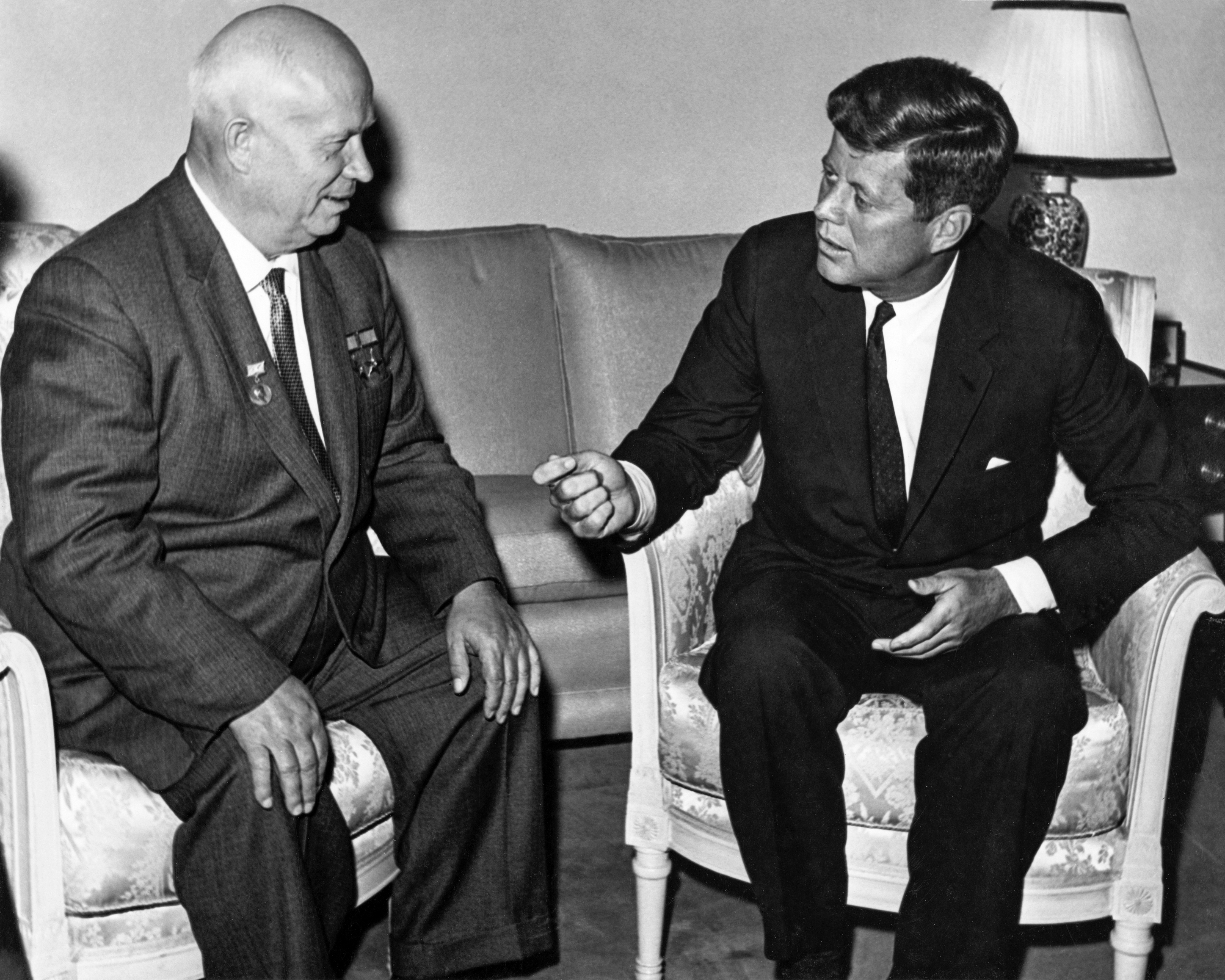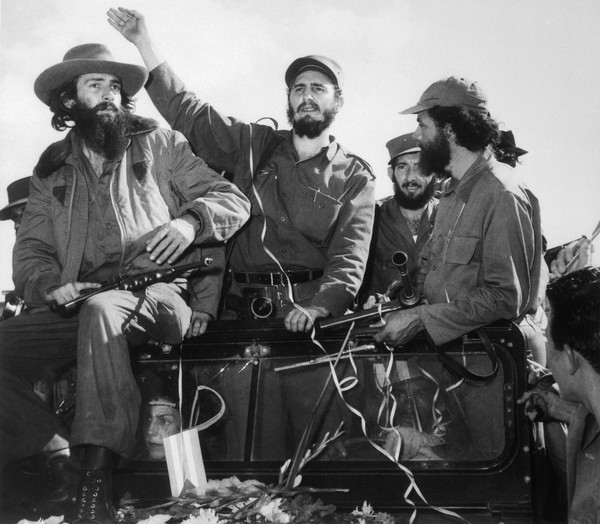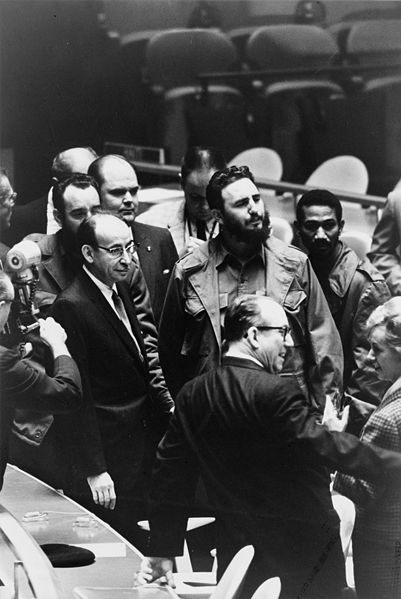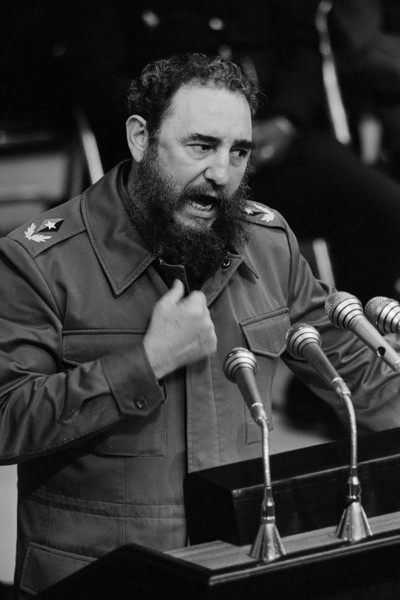Photobank. Library Images
-
1962
selection of archival photographs on the history of Cuba. On photo - U.S. President John F. Kennedy (John F Kennedy) spoke on television,
 announcing the blockade of Cuba during the crisis ' Cuban Missile Crisis
announcing the blockade of Cuba during the crisis ' Cuban Missile Crisis ', October 24, 1962.
Selected archive photographs on the history of Cuba. the picture - people are looking speech of U.S. President John F. Kennedy (John F. Kennedy)
 on television to declare the blockade of Cuba during the Cuban Missile Crisis, California, USA, October 1962.
on television to declare the blockade of Cuba during the Cuban Missile Crisis, California, USA, October 1962.  the blockade of Cuba during the Cuban missile crisis, Los Angeles, USA, 1962.
the blockade of Cuba during the Cuban missile crisis, Los Angeles, USA, 1962. Fidel Castro (Fidel Castro) appears in Havana a few weeks before beginning of the Cuban Missile Crisis, September 6, 1962.

selection of archival photographs on the history of Cuba. The photo - a demonstration of 'Campaign for Nuclear Disarmament' in Oxford Street
 against U.S. actions against Cuba, London, 1962.
against U.S. actions against Cuba, London, 1962. selection of archival photographs on the history of Cuba. On photo - demnstratsiya after attack the ship 'The Courbre', Cuba, March 4, 1962.

selection of archival photographs on the history of Cuba. the picture - the people pray for peace during the Cuban missile crisis (Cuban missile crisis), October 1962.

 John Kennedy (John Kennedy) stands in Louisville, Ky., Oct. 24, 1962. John Kennedy (John Kennedy) in Aliquippa, Pennsylvania, October 24, 1962.
John Kennedy (John Kennedy) stands in Louisville, Ky., Oct. 24, 1962. John Kennedy (John Kennedy) in Aliquippa, Pennsylvania, October 24, 1962. 
Selected archival photographs on the history of Cuba. the picture - the armed wing 'Frente Nacional Escambray',
 opposed to Castro, Valmaseda (Valmaseda), Cuba, April 1962.
opposed to Castro, Valmaseda (Valmaseda), Cuba, April 1962.  Soviet Ambassador Anatoly Dobrynin in the U.S. talks to the press after presenting his credentials President John F. Kennedy (John Kennedy), 2 April 1962.
Soviet Ambassador Anatoly Dobrynin in the U.S. talks to the press after presenting his credentials President John F. Kennedy (John Kennedy), 2 April 1962.  Soviet Ambassador to the U.S. Anatoly Dobrynin, to his wife, Washington, 1962.
Soviet Ambassador to the U.S. Anatoly Dobrynin, to his wife, Washington, 1962.  October 1962.
October 1962. October 22, 1962, the government United States announced the discovery of Soviet missiles in Cuba. In the relations between the USSR and the U.S. broke the Caribbean (Cuba) crisis. Where to stay in Cuba of Soviet ballistic missiles by the Soviet leadership was seen as retaliation for the deployment of U.S. missiles in Turkey and Italy, as well as the threat of American invasion Troops in Cuba.
 Background
Background decision to deploy missiles was taken Politburo May 24 In 1962 after the failure of U.S. efforts initiated by the Cuban counter-revolutionary forces landed at Playa Girón (Bay of Pigs) in April 1961 and in connection with which became known to the Soviet government, U.S. military plans against Cuba. In one of his speeches, NS Khrushchev said that if the U.S. moved to Cuba, the Soviet cause on them back. According to Khrushchev, to provide defense against a possible U.S. invasion of Cuba in conventional arms was not possible. Only missiles with nuclear warheads could be a reliable deterrent to possible U.S. aggression.
To perform this task, it was decided (Code-named "Anadyr") to place in Cuba missile divisions composed of three regiments of the medium-range missiles R-12 (24 launchers), and two regiments of missiles R-14 (16 launchers). Missile range ensured the defeat of the major facilities in the United States.
total number of Soviet troops Cuba amounted to 43 thousand people. To transport personnel with weapons and equipment were deployed to 80 ships the Navy of the USSR. July 12, 1962 began loading personnel and equipment at the ports of the Baltic, Black and Barents Seas.
escalating conflict
After getting through the channels of its intelligence information about the increasing number of Soviet "experts" and deployed their "strange and new" activities on the island, U.S. officials have warned the government USSR about the serious consequences of the inevitable expansion of Soviet or Cuban capacity to attack the United States. In his reply the Government of the USSR stated that the supply of arms and military equipment to Cuba shall "solely for defense purposes." October 14 U.S. intelligence U-2 aircraft in the vicinity of San Cristobal (Pinar del Rio) have been found and photographed the starting positions of Soviet missile forces. October 16, 1962 The CIA reported to the U.S. President John F. Kennedy. In the short term has been defined by the Americans and the type of missiles.
Oct. 22, the U.S. government announced the discovery of missiles in Cuba. Fifteen minutes after the announcement of Americans chief Sun Fidel Castro declared combat anxiety and general mobilization. The number of Armed Forces of the Republic of Cuba was at that time about 400,000 people.
detection by U.S. reconnaissance aircraft in the territory Island ready for installation of Soviet medium-range missiles gave grounds for the U.S. accusation that for several months decision of the Soviet government on the island created the conditions for application of nuclear missile attack on the U.S.. USSR mouths of their diplomatic representatives abroad, has denied these accusations, though, as it became known later, the Soviet diplomats had no information about what actually happened Cuba, like that of missiles have already been equipped with multiple warheads, and Soviet military commanders on the ground is authorized to make a decision on their application.
«On the eve of" third world
culmination of the crisis was the speech of U.S. President John F. Kennedy on television October 22, 1962, in that "as a first step," declared a naval blockade of Cuba and the Soviet Union was brought ultimatum immediately remove Soviet missiles from the island. Kennedy ordered to withdraw to the Caribbean Sea Fleet compounds, as well as lead the embattled strategic aviation. U.S. Navy, designed to organize the blockade consisted of 238 ships: 8 aircraft carriers, two cruisers, 118 destroyers, 13 submarines, 65 amphibious and 32 subsidiary ships. At Florida has been concentrated almost 250000th group of U.S. troops, composed of Marine Corps aviation, amphibious, armored and other divisions, corps and units. Soviet Government in response stated that the strike "the most powerful retaliation." In the Soviet Union were brought into high-alert the willingness of all armed forces and in the first place - the SRF.
Within a few days of the crisis the world was closer to a third world war involving nuclear weapons than ever throughout the postwar decades. Demonstrating commitment to apply extreme measures was accompanied by active advocacy campaign in the USSR and the USA, designed to provide a psychological impact on the opposite side.
The UN Security Council, which asked with the requests of the USSR, Cuba and the United States, hearings were held.
October 26, when it became clear that the U.S. is determined at any cost to remove the missiles, Khrushchev sent Kennedy more conciliatory message. He admitted that in Cuba there is a powerful Soviet weapons, but urged the President that the USSR is not going to attack America.
Oct. 27 came the "black Saturday" Cuban missile crisis. In those days over Cuba in order to intimidate twice a day, rushing squadron of U.S. aircraft. On this day in Cuba was hit by an American spy plane U-2 overflew field position area of missile troops. The pilot, Major Anderson was killed.
weakening opposition
October 28 in order to avoid further aggravation of the international situation, which threatened to escalate into military confrontation with unpredictable consequences until the beginning of a new world war, the Soviet Government considered it prudent to accept the U.S. demand the withdrawal of Soviet missiles from Cuba in exchange for assurances the U.S. government respect for the territorial integrity of the island, guarantees of non-interference in the internal affairs of that country. In a confidential manner was also made to withdraw U.S. missiles from Turkey and Italy. November 2, President Kennedy announced that the Soviet Union dismantle their missiles in Cuba. From 5 to 9 November missiles from Cuba, were removed. Nov. 21 U.S. canceled a naval blockade. 12 December 1962 the Soviet has completed withdrawal of troops, missile weapons and equipment. In January 1963, the UN has received assurances of the Soviet Union and the United States that the Cuban crisis has been eliminated.
 to prepare for an attack, Fort Pierce (Ft. Pierce), Florida, USA, 1962.
to prepare for an attack, Fort Pierce (Ft. Pierce), Florida, USA, 1962. selection of archival photographs on the history of Cuba. the photo - Cuban police at the time of the Caribbean crisis on the brink of nuclear war.
 Nuclear warheads were launched by U.S. President John F. Kennedy assured Soviet leader Nikita Khrushchev that the U.S. does not capture Cuba, October 1962.
Nuclear warheads were launched by U.S. President John F. Kennedy assured Soviet leader Nikita Khrushchev that the U.S. does not capture Cuba, October 1962. selection of archival photographs on the history of Cuba. the picture - the student demonstrations in front of the embassies of America Moscow
 against an invasion of Cuba supported the states of Cuban military forces.
against an invasion of Cuba supported the states of Cuban military forces. selection of archival photographs on the history of Cuba. The photo - a demonstration of Russian students against the blockade of Cuba by the U.S. Army.

selection of archival photographs on the history of Cuba. On photo - Cuban dictator Fulgencio Batista (Fulgencio Batista).

selection of archival photographs on the history of Cuba. The photo - a sign the hospital 'Lenin Hospital', built with funding from the USSR.

selection of archival photographs on the history of Cuba. The photo - a Soviet tanker unloads oil, Havana, Cuba, October 20, 1960.

selection of archival photographs on the history of Cuba. The photo - a Soviet cargo ship returns from Cuba in the USSR.

Fidel Castro and the Cuban Revolution
Cuban Revolution - armed struggle for power in Cuba, which began July 26, 1953 and ended January 1, 1959 victory for the insurgents.
in a coup on March 10, 1952 to power in Cuba came to Fulgencio Batista, who established the country's military-police dictatorship. The coup has caused discontent among progressive-minded youth, the most radical group which is headed young lawyer and aspiring politician, Fidel Castro Ruz. * July 26, 1953 rebel group, relying on grassroots support, led by Fidel Castro came to storm the fortified barracks Moncada in Santiago de Cuba. After two hours of fighting rebel force was defeated, many revolutionaries were killed, the others tried. At the trial, Fidel Castro has defended himself by abandoning a lawyer and made his famous speech "History will justify me." Although all of the defendants received lengthy prison terms (Fidel Castro was sentenced to 15 years), under public pressure to Batista were soon amnesty insurgents. Castro brothers emigrated to Mexico, where they have left no plans to overthrow the Batista dictatorship and began to create an organization for the future of the revolutionary performances, known as M-26. In Mexico, by the time the traditional stronghold of revolutionaries from across the region, there was a meeting between Castro and Ernesto "Che" Guevara who joined the M-26.

heroes of the Cuban Revolution.
left to right: Fidel Castro, Raul Castro and Ernesto "Che" Guevara. Around 1956
 * 2 December 1956 from the yacht Granma landed in Oriente province, the rebel force of 82 people. In addition to landing landing revolutionaries assumed organize the concert and in Cuba itself, but it was quickly suppressed, she had almost finished planting disaster because the landing was immediately discovered by government troops, and only narrowly escaped total destruction. Of the participants only survived the landing 11 (according to other reports 22 - see the July 26 Movement).
* 2 December 1956 from the yacht Granma landed in Oriente province, the rebel force of 82 people. In addition to landing landing revolutionaries assumed organize the concert and in Cuba itself, but it was quickly suppressed, she had almost finished planting disaster because the landing was immediately discovered by government troops, and only narrowly escaped total destruction. Of the participants only survived the landing 11 (according to other reports 22 - see the July 26 Movement). During the first three months, the situation remained critical of revolutionaries, but they managed to win trust inhabitants of the region and organize a significant military pressure on the local military garrison. In addition to conducting combat operations in rural areas M-26 with the help of sympathetic elements among the students and the armed forces held a number of speeches in towns that do not really have much values. Greatly helped the rebels by the fact that the Batista government in this period was at loggerheads with the main economic partner and military supplier of Cuba at that time, the United States.
Since the summer of 1958 the strategic initiative shifted to the side of the revolutionaries. By the autumn under the control of the rebels were set almost entirely the province of Oriente and Las Villas.


Fidel Castro (Fidel Castro) appears before the crowd after the victory of the revolution in Havana, 1959.

Fidel Castro (Fidel Castro) after defeating the Revolution in Havana, 1959.

Fidel Castro (Fidel Castro) on the balcony of the hotel 'Hilton' after the revolution in Havana, 1959.

Cuban revolutionary Ernesto "Che" Guevara (Che Guevara), 1959.

Cuban revolutionary Ernesto "Che" Guevara (Che Guevara), January 5 1962.

selection of archival photographs on the history of Cuba. The photo - a hero of Cuba, Che Guevara (Che Guevara), Havana, Cuba, January 21, 1962.

Selected archive photographs on the history of Cuba. the picture - topless Ernesto Che Guevara (Ernesto Che Guevara),
 which by that time was head of the National Bank of Cuba and Minister of Industry, helps the workers on the construction site on the outskirts of Havana.
which by that time was head of the National Bank of Cuba and Minister of Industry, helps the workers on the construction site on the outskirts of Havana. selection of archival photographs on the history of Cuba. On photo - Cubans celebrate the victory of the revolution, Havana, Cuba, 1959.

Fidel Castro (Fidel Castro) appears in the program The Ed Sullivan Show on channel CBS, Havana, Cuba, January 11 1959.

Fidel Castro (Fidel Castro) appears in the program The Ed Sullivan Show on channel CBS, Havana, Cuba, January 11, 1959.

Fidel Castro (Fidel Castro) and Ernest Hemingway (Ernest Hemingway), the end of 1959.

Fidel Castro (Fidel Castro), surrounded by young people, Cuba, about 1960.
 NS Leonov, VA Borodaev « Fidel Castro. Political biography
NS Leonov, VA Borodaev « Fidel Castro. Political biography »
Chapter VI. Choosing a way (excerpt)
in September 1960 in New York began its work XV Anniversary Session of UN General Assembly, which arrived the prime ministers of countries - members of the UN. Took decision to travel to New York and Fidel Castro, although relations between the two countries were very tense. For example, obviously acting on orders from authorities и продажного руководства профсоюзов, персонал аэропорта в Нью-Йорке заявил, что он не будет даже разгружать багаж кубинской делегации, если приедет Фидель Castro. But such harsh measures, it was impossible to intimidate Cuban leaders, past thorny path of the most difficult tests. Learning of this, only Fidel said: «Well, what? We just did not take any luggage with him, and go hiking with knapsacks. We even that imperialists have not deliver fun! "
11 days held by Fidel in the U.S. (from 18 to 28 September 1960), were filled with vicious small injections, which the authorities are right, U.S. forces were trying to ruffle and to provoke the Cuban delegation. Police and the FBI did their best to completely isolate Fidel Castro from communicating with the public. Airplane Cuban delegation was towed into the most remote corner of the airport, and there is trying to take Castro at the hotel, despite the fact that thousands gathered at the airport people to meet the Prime Minister of Cuba. When Fidel tried out the car window to greet met, then one of the officers in the untenable the form of trying to deny it to him, which caused a sharp rebuff from Fidel Castro, and then caused an energetic protest to the Secretary-General UN. Despite all the efforts of U.S. authorities, more than 100 cars, 25 buses and several trucks, crowded with enthusiastic supporters of the Cuban Revolution accompanied by Fidel Castro. Mounted police blocked all the approaches to the hotel, "Shelburne", which originally stood delegation, leaving, however, complete freedom of counterrevolutionary groups constantly picketing the hotel.
Just the other day, the owner of the hotel scandal, demanding a sharp increase fees for Cubans living on the pretext that, say, the presence of Fidel Castro gives him particular concern. No exhortations have failed. Then Fidel, indignant provocative behavior of the host hotel, ordered that one member of the delegation went to the store and bought a few tents that the Cubans intended to divide the territory of the United Nations because the U.S. does not respect the representatives of the countries - members of the UN. The entire delegation immediately left the UN, where he met with Dag Hammarskjold, who was thrown into the heat of the message to him accommodation plan delegation in the garden of the UN building. The situation was mitigated received at this time call the owner of a modest hotel "Theresa" from Harlem, who offered to provide free accommodation for their Cubans. Hammarskjold tried to dissuade Fidel references to the fact that the hotel is too miserable for the delegation of such level, but Fidel said that it is this, and do, and Cubans, along with tents and duffel bags headed for Harlem.
In this hotel met Fidel Castro, Nikita Khrushchev, Gamal Abdel Nasser and other political leaders.

Fidel Castro (Fidel Castro) Antonio Nunez (Antonio Nunez) and Raul Roa (Raul Roa) at a meeting at the UN, New York, 1960.

Fidel Castro, president of Cuba, at a meeting of the United Nations General Assembly. 22 Sept. 1960

Fidel Castro (Fidel Castro) appears perd reporters after the Assembly of the UN New York, September 1960.

Fidel Castro (Fidel Castro), about 1960.

U.S. has almost no secret that they kept it for a military intervention in Cuba. Settled in their territory who emigrated from Cuba, politicians, economists, business leaders, etc., have created a so-called Revolutionary Movement revival with the aim of overthrowing the Cuban government and "save the country from the threat of communism." This meant that the United States is prepared not only to military invasion, but also form a political force that could take control of the country after the overthrow of the hated regime.

 In early 1961 the development of events was just dizzy. Already on January 3 U.S. said that they sever diplomatic relations with Cuba.
In early 1961 the development of events was just dizzy. Already on January 3 U.S. said that they sever diplomatic relations with Cuba. opinion of the American diplomatic staff was a prelude to military action. Leadership of the revolution did not hide from the masses of danger of the moment. More Sept. 28, the day of his return from New York, when Fidel Castro spoke at the rally with a report on progress to the people there work in response to there was an explosion of firecrackers (to disrupt the speech), he gave the slogan of the establishment across the country Committees for the Defence of the revolution that should have mobilized the entire nation to fight against internal and external dangers. Committees of Defense of the Revolution became effective complement to the armed forces of the Republic and the People's Militia. They sent the tip of their fight against terrorists, saboteurs and agents foreign intelligence services, who tried to disrupt the country's economic life. It was a system of collective revolutionary vigilance. In each quarter in the cities, in each village or township in rural committees were established to defend the revolution, which took control of the slightest movement of the counter-revolutionary elements that have paralyzed any possibility of a conspiratorial group work.
In mid-January 1961, Fidel Castro asked the new president John F. Kennedy, had just assumed power with a proposal to discuss the relationship between the two countries. Kennedy refused. He already knew that preparations for the invasion ended.
 April battle 'Bay of Pigs', 14 June 1961. prisoners were released in December 1962 for the supply of medicines the amount of $ 53 million.
April battle 'Bay of Pigs', 14 June 1961. prisoners were released in December 1962 for the supply of medicines the amount of $ 53 million. « Yuri Gagarin and Fidel Castro
 » on Yandeks.Fotkah
» on Yandeks.Fotkah . 1961
Fidel Castro, and Yuri Gagarin. 1961

Fidel Castro (Fidel Castro) with Nikita Khrushchev in Moscow, 1963.

Fidel Castro (Fidel Castro) with Nikita Khrushchev in Moscow, 1963.


Fidel Castro (Fidel Castro) with Nikita Khrushchev in Moscow 1964.

Fidel Castro (Fidel Castro) and Leonid Brezhnev, about 1965.

Fidel Castro (Fidel Castro) acts in Cuba about 1965.

Fidel Castro (Fidel Castro) to play baseball, 1965.

Fidel Castro (Fidel Castro) shows the photograph in which genearl Ovando Candia (Ovando Candia) and other Bolivian military celebrate the death of Che Guevara (Che Guevara), July 1968.

Fidel Castro (Fidel Castro), Havana, 1977.

Fidel Castro (Fidel Castro) speaks at the UN General Assembly, 1979.

Fidel Castro (Fidel Castro) speak at the General UN General Assembly, New York, 12 October 1979.

Fidel Castro (Fidel Castro) appears in Havana, 1988.
0 comments:
Post a Comment